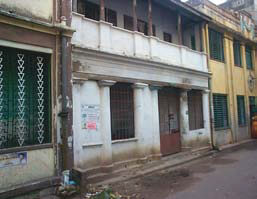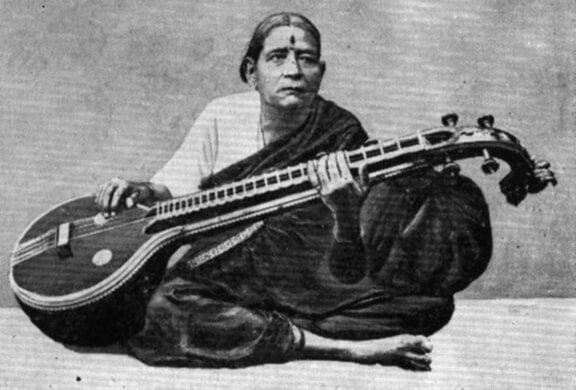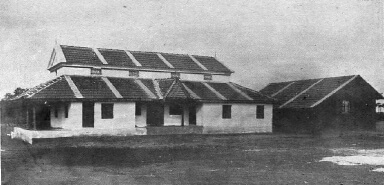Registered with the Registrar of Newspapers for India under R.N.I 53640/91
Vol. XXIX No. 18, January 1-15, 2020
Lost Landmark of Chennai
A home for the fine arts
For years it stood, its white pilaster façade hiding its rich musical history. The music had of course long fled and even memories had faded sometime in the first decade of the present century. The house had of late been used a godown and even that use was not vouchsafed to it in recent months, when it fell victim to the wrecker’s hammer. The home of Veena Dhanammal in Ramakrishna Chetty Street, George Town is no more.
Finding the house and the thoroughfare in which it stood was always quite tough. I still remember the thrill of getting lost one day in that area sometime in the early 2000s and having taken a wrong turn, finding myself in front of it. T. Mukta, the last surviving granddaughter of Veena Dhanam had described the house to me and seeing a photo of it in Enkay Visions’ documentary on Dhanammal helped. I knew I was standing in front of the correct house. The then owner, a Telugu-speaking woman, lived next door and was happy to show me around the place. I walked in to the narrow entrance vestibule, wandered through the ground floor and then gingerly climbed up the rickety wooden steps to the first floor. There was a room there, fronted by a verandah. All was silence. And yet, it had always not been so.

Veena Dhanammal’s house
Dhanammal, the famed veena artiste who traced her lineage in the arts through several generations of formidable women, had come down in life by the time she had moved in here. Her principal patron-in-chief Dharmapuri Subbarayar had passed away and her financial profligacy had ensured that the ancestral home on Nattu Pillaiyar Koil Street gifted to grandmother Kamakshi by her patron Rangoon Krishnaswami Mudaliar had been auctioned off to settle creditors. The Ramakrishna Chetty Street house was rented and this is where Dhanam moved in with her four daughters and brood of several grandchildren. One of the chief advantages of the location was its proximity to the residence of ‘Jalatarangam’ Ramaniah Chetty, the local chit fund owner, whose generosity was boundless towards Dhanam and her family. In fact, she often stayed for days on end at his house, teaching music to his daughters.
It was in the house in Ramakrishna Chetty Street that Dhanam’s famed Friday evening concerts took place. A reclusive personality who spoke little, she received visitors on this day and they quietly made their way to the tiny room on the first floor. There Dhanam held court, veena in hand. Near-blind by then, she was kept informed as to who had come and she would throw each visitor a curt word of welcome. And then the veena performance would begin. Nobody could speak, keep time, clear their throat, sneeze or clap. Vendors shouting out their wares would be turned away at the entrance of the street and neighbouring households would reduce all activity to a minimum to ensure perfect silence was maintained. The performance lasted till 8.00 p.m. when the cannon in Fort St George sounded the hour. The numbers that attended these performances were small – the room could not accommodate more than 30 people at any time – but they were all great scholars and aficionados of the art. Discreet donations and contributions by these people kept the old lady financially afloat.
Not that Dhanam really cared. It was said that on one occasion that a visiting Taluqdar of Awadh was so blown away by her veena recital that he placed Rs 116 at her feet. Dhanam immediately asked Ramaniah Chetty to fetch Abdul Kareem Khan of the Kirana Gharana who was then visiting the city and was a great fan of her’s. A performance by the ustad followed and the money was given to him as his fee.
This was from where Dhanam watched with sardonic humour the genesis of the December Music Season and wondered as to what this place called the Music Academy was where they ‘spoke’ about music. This was also the home to which several musicians came of an afternoon, to learn some songs. The names are legendary – Ariyakkudi Ramanuja Iyengar, Musiri Subramania Iyer, Parur Sundaram Iyer, Madras Lalithangi and Tiruvarur Rajayi. In some cases it was an exchange – Dhanam taught and learnt from Kanchipuram Naina Pillai. To some she gave freely – Calcutta Gauhar Jan and Abdul Kareem Khan learnt Carnatic songs from her and released discs of these. Some she adored and they reciprocated in full – Tiruvottiyur Tyagier and Tiger Varadachariar were two such. A younger musician whose talents she admired was the nagaswaram maestro Tiruvavaduturai Rajarathinam Pillai. On some days there would be distinguished compatriots from the courtesan community – Kanchipuram Dhanakoti Ammal was a frequent visitor as was the gutsy and talented Bangalore Nagarathnamma. It was in this house that many of her grandchildren took their first steps in music – T. Sankaran as a writer, scholar and historian, the sisters T. Brinda and Mukta became singers while sibling Abhiramasundari became a violinist, T. Balasaraswathi took to dance while her brothers Viswanathan and Ranganathan became flautist and mridangist respectively. Taken overall, the musical heritage of this humble home is the stuff of legend.
Also legendary were Dhanam’s Navaratri celebrations. A bower of jasmine would be put up on the terrace and Dhanam having bathed in rosewater, clad herself in white silk and adorned her veena with a string of fragrant flowers, would seat herself under it. The entire family gathered around and sang Muthuswami Dikshitar’s Veena Pustaka Dharinim (raga Vegavahini). To them their matriarch was Saraswati, the Goddess of Learning.
By 1937, Dhanam was sinking. A trio who regularly called on her and delighted in music at this time comprised T.T. Krishnamachari, then businessman and a leading light of the Congress (later to become Union Minister), S.Y. Krishnaswami, ICS and N.D. Varadachariar, lawyer. Another regular was R. Rangaramanuja Iyengar, the fiery and acerbic music critic and scholar, who learnt from her. It is essentially from the writings of these people that we get a clear picture of her personality. In the last year of her life, Dhanam took to moving between the residences of her daughters and it was at the home of T. Jayammal, her third child, that she passed away in October 1938. The pallbearers included T.T. Krishnamachari, violinist Papa K.S. Venkataramiah and Kasturi Srinivasan of The Hindu.
The home in Ramakrishna Chetty Street was given up and later its owners disposed it to the family of the lady who showed me around. A few years ago it changed hands once again, this time to a businessman who converted it into a godown. Now it has been demolished as well.
 Veena Dhanammal.
Veena Dhanammal.
Early in the 2000s, I used to take people on heritage tours of the house and it was fun to wander around the place, peeking into the vestibule where Dhanam rested during the afternoons, seeing the room where she performed and wondering at the tiny ground floor space where T. Balasaraswathi took her first steps in dance. During one such visit, artiste Amrita Murali sang Veena Pustaka Dharinim. It filled the house with music, for the last time.
 Pictorial History of Southern India. It is quite amazing as to how this column on Lost Landmarks results in fresh discoveries. I had written about Dr. A. Lakshmipathy’s Arogya Ashrama in Avadi in MM XXIX No. 8, August 1-15, 2019. Now Karthik Bhatt sends us a picture of the same, discovered in the 1928 issue.
Pictorial History of Southern India. It is quite amazing as to how this column on Lost Landmarks results in fresh discoveries. I had written about Dr. A. Lakshmipathy’s Arogya Ashrama in Avadi in MM XXIX No. 8, August 1-15, 2019. Now Karthik Bhatt sends us a picture of the same, discovered in the 1928 issue.

